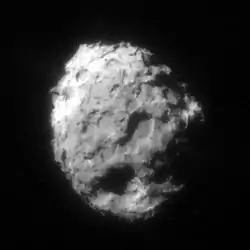P/1997 B1 (Kobayashi)
On January 30 and January 31, 1997, Takao Kobayashi observed an object, P/1997 B1 (Kobayashi), which was initially thought to be a minor planet and was reported to the IAU as such by S. Nakano. Over the next few days, the object was observed to be in a cometary orbit. W. Offutt later showed it to be a comet.[1] For discovery of a comet with CCD, as well as the faintest discovery, Kobayashi ranks the first among amateur astronomers. It demonstrates that amateur astronomers still have an important role to play in the field of astronomical object discovery.[2]
| Discovery | |
|---|---|
| Discovered by | Takao Kobayashi |
| Discovery date | January 30, 1997 |
| Orbital characteristics A | |
| Epoch | 2450520.5 (March 13, 1997) |
| Aphelion | 15.121 AU |
| Perihelion | 2.055 AU |
| Semi-major axis | 8.588 AU |
| Eccentricity | 0.761 |
| Orbital period | 25.17 a |
| Inclination | 12.36° |
| Last perihelion | March 2, 1997 |
| Next perihelion | March 25, 2022 |
See also
References
- "THE ASTRONOMER Electronic Circular No 1171". THE ASTRONOMER. Retrieved 2009-12-22.
- "Current comets". Jonathan Shanklin. Retrieved 2009-12-22.
External links
- "IAUC 6553: P/1997 B1". IAU: Central Bureau for Astronomical Telegrams. Central Bureau for Astronomical Telegrams. Retrieved 2016-01-17.
- "IAUC 6554: P/1997 B1; 1997X". IAU: Central Bureau for Astronomical Telegrams. Central Bureau for Astronomical Telegrams. Retrieved 2016-01-17.
- "P/1997 B1 (Kobayashi)". JPL Small-Body Database Browser. Jet Propulsion Laboratory, California Institute of Technology. Retrieved 2016-01-17.
- "P/1997 B1 (Kobayashi)". Kazuo Kinoshita. Retrieved 2016-01-17.
This article is issued from Wikipedia. The text is licensed under Creative Commons - Attribution - Sharealike. Additional terms may apply for the media files.

